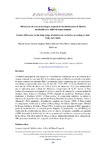Mostrar o rexistro simple do ítem
Diferencias de sexo en la imagen corporal de los adolescentes de Huelva atendiendo a su índice de masa corporal
| dc.contributor.author | Arrayás Grajera, Manuel Javier | |
| dc.contributor.author | Díaz Bento, Martín Salvador | |
| dc.contributor.author | Tornero Quiñones, Inmaculada | |
| dc.date.accessioned | 2019-05-08T12:04:50Z | |
| dc.date.available | 2019-05-08T12:04:50Z | |
| dc.date.issued | 2018 | |
| dc.identifier.citation | Sportis, 2018, 4 (2):232-254 ISSN: 2386-8333 | es_ES |
| dc.identifier.issn | 2386-8333 | |
| dc.identifier.uri | http://hdl.handle.net/2183/22830 | |
| dc.description.abstract | [Resumen] El objetivo principal de este estudio es comprobar las diferencias en la percepción de la imagen corporal (en adelante IC) de los adolescentes de Huelva atendiendo a su índice de masa corporal (en adelante IMC). La muestra estuvo compuesta por 226 estudiantes, con edades comprendidas entre 12 y 18 años (M= 13,94; DT= 1,41). La distribución por sexo fue de 54,9% de chicos (n= 124) y 45,1% de chicas (n= 102). Los instrumentos que se utilizaron para evaluar los diferentes componentes de la IC fueron: 1) Para evaluar el componente perceptual se utilizó el método de estimación corporal global de Gardner, Stark, Jackson y Friedman (1999), adaptado al español por Rodríguez, Beato, Rodríguez y Martínez (2003). 2) Para evaluar el componente subjetivo se utilizó la subescala de insatisfacción corporal del Eating Disorders Inventory de Garner, Polivy y Olmstead (1983), adaptado a la población española por Garner (1998). 3) Para evaluar el componente conductual se utilizó el Body Image Avoidance Questionnaire (BIAQ), de Rosen, Salzberg, Srebnik y Went (1991). A medida que aumenta el IMC aumenta el grado de insatisfacción, la obsesión por la delgadez, la puntuación total del BIAQ y la restricción de comida tanto en chicos como en chicas. Asimismo, a medida que aumenta el IMC desciende la bulimia de los chicos y aumenta la tendencia a pesarse y acicalarse de las chicas. Más de la mitad de chicos y chicas independientemente de la categoría del IMC presentan insatisfacción corporal con el deseo de perder peso. | es_ES |
| dc.description.abstract | [Abstract] The main objective of this study is to check the differences in the perception of the body image (hereinafter IC) of the adolescents of Huelva according to their body mass index (hereinafter BMI). The sample consisted of 226 students, aged between 12 and 18 years (M= 13.94; DT= 1.41). The distribution by sex was 54.9% of boys (n=124) and 45.1% of girls (n=102). The instruments used to evaluate the different components of the CI were: 1) To evaluate the perceptual component, the global body estimation method of Gardner, Stark, Jackson and Friedman (1999) was used, adapted to Spanish by Rodríguez, Beato, Rodríguez and Martínez (2003). 2) To evaluate the subjective component, the Eating Disorders Inventory subscale of body dissatisfaction by Garner, Polivy and Olmstead (1983), adapted to the Spanish population by Garner (1998), was used. 3) The Body Image Avoidance Questionnaire (BIAQ) by Rosen, Salzberg, Srebnik and Went (1991) was used to evaluate the behavioral component. As the BMI increases, so does the degree of dissatisfaction, the obsession with thinness, the BIAQ base score, and food restriction in both boys and girls. Also, as the BMI increases, boys' bulimia decreases and girls' tendency to weigh and groom themselves increases. More than half of boys and girls, regardless of BMI category, are dissatisfied with their desire to lose weight. | es_ES |
| dc.language.iso | spa | es_ES |
| dc.publisher | Universidade da Coruña | es_ES |
| dc.rights | Atribución-NoComercial-SinDerivadas 3.0 España | es_ES |
| dc.rights.uri | http://creativecommons.org/licenses/by-nc-nd/3.0/es/ | * |
| dc.subject | Imagen corporal | es_ES |
| dc.subject | Adolescentes | es_ES |
| dc.subject | Índice de masa corporal | es_ES |
| dc.subject | Body image | es_ES |
| dc.subject | Adolescents | es_ES |
| dc.subject | Body mass index | es_ES |
| dc.subject | Body image | es_ES |
| dc.title | Diferencias de sexo en la imagen corporal de los adolescentes de Huelva atendiendo a su índice de masa corporal | es_ES |
| dc.title.alternative | Gender differences in the body image of adolescents in Huelva according to their body mass index | es_ES |
| dc.type | info:eu-repo/semantics/article | es_ES |
| dc.rights.access | info:eu-repo/semantics/openAccess | es_ES |
| UDC.journalTitle | Sportis | es_ES |
| UDC.volume | 4 | es_ES |
| UDC.issue | 2 | es_ES |
| UDC.startPage | 232 | es_ES |
| UDC.endPage | 254 | es_ES |
| dc.identifier.doi | https://doi.org/10.17979/sportis.2018.4.2.3310 |






